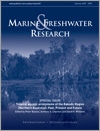
Marine and Freshwater Research
Volume 69 Number 7 2018
Tropical Aquatic Ecosystems of the Kakadu Region (Northern Australia): Past, Present and Future
MFv69n7_EDKakadu's wetlands: more change is afoot
MF18158Wetland research and management in the Kakadu region of northern Australia
This paper provides an introduction to the ecological features that characterise the wetlands of the Kakadu region in tropical northern Australia, including gaps in the understanding of the ecosystem services they provide, and a comment on the emergence of novel ecosystems as a consequence of global change, in particular sea-level rise and an anticipated transition of freshwater wetlands to saline conditions.
MF16107Sediment fluxes and sinks for Magela Creek, Northern Territory, Australia
Sediment fluxes and sinks based on total sediment load for Magela Creek in the Australian wet–dry tropics have been constructed from detailed measurements of turbidity, suspended sand and bedload for the 10-year period from 2001–2002 to 2010–2011. The present work showed that the sediment-trap efficiency of the vegetated wetlands on lower Magela is high at ~89.5%.
MF17256Defining the importance of ecological processes for monitoring aquatic habitats for conservation and rehabilitation objectives at the Ranger uranium mine, Kakadu Region, Australia
Consideration of ecological processes is required to ensure the success of ecological restoration and conservation activities. An assessment was conducted to ensure that current and future environmental monitoring programs are in place to safeguard the protection of aquatic ecological processes, particularly in the context of rehabilitation of Ranger uranium mine.
MF17065Historical perspectives on the mangroves of Kakadu National Park
Mangroves in Kakadu National Park in Australia’s Northern Territory have undergone significant changes, occupying much of the lowlands c. 6000 years ago, but are now confined to the river margins and islands. Recent observations from satellite and aircraft have indicated that fluctuations in sea level exert a significant effect on the distribution of mangroves, with a drop in the sea level from 2015 to 2016 contributing to unprecedented dieback on the landward margins.
MF16049Assessing sea level-rise risks to coastal floodplains in the Kakadu Region, northern Australia, using a tidally driven hydrodynamic model
The coastal floodplains of the Kakadu Region of northern Australia are highly vulnerable to future sea level rise (SLR) and extreme weather events. A hydrodynamic model was developed to simulate the frequency and extent of saltwater inundation of future SLR scenarios from 2013 to 2100 (1.1 m above mean sea level), and was used to assess potential risk to freshwater floodplains.
MF16118Seasonal habitats, decadal trends in abundance and cultural values of magpie geese (Anseranus semipalmata) on coastal floodplains in the Kakadu Region, northern Australia
The magpie goose is an iconic tropical species highly valued as a conservation asset and by Aboriginal people as a cultural resource. Their spatial and temporal dynamics in the Kakadu Region of Northern Australia are characterised at seasonal and decadal time scales using long-term aerial survey data. The customary harvesting practices of geese and their eggs in the region show that their cultural value extends beyond consumption of bush-food.
MF16175Vulnerability of fish and macroinvertebrates to key threats in streams of the Kakadu region, northern Australia: assemblage dynamics, existing assessments and knowledge needs
Key stream fauna in Kakadu National Park face severe threats in 100+ years associated with climate change, invasive species, and mine-site rehabilitation. Sea level rise will salt the coastal floodplains and the fauna must then rely on reduced upstream refuges vulnerable to strong swings between more intense El Niños and La Niñas. Rates and extremes of future climate change appear unprecedented, making predictions associated with past climate change unreliable.
MF16033Bacteria in tropical floodplain soils are sensitive to changes in saltwater
Sea-level rise associated with global warming will increase across Kakadu causing widespread saltwater intrusion. We aimed to understand how soil bacteria might respond to these impacts, by sampling transects in different river zones. We found diverse bacterial communities that were sensitive to soil variables, suggesting that saltwater intrusion may affect bacterial contributions to the dynamic floodplain ecosystems of Kakadu.
MF16148Dynamics of plant communities and the impact of saltwater intrusion on the floodplains of Kakadu National Park
On the Kakadu floodplains, the distribution of different plant communities varies yearly, related to flooding duration and water depth. Because these floodplains are close to the coast, they are vulnerable to saltwater intrusion as the sea levels rise. The most obvious effect of this will be the transformation from freshwater vegetation to salt-tolerant plants in susceptible areas.
MF18067Sea-level rise in northern Australia's Kakadu National Park: a survey of floodplain eukaryotes
The floodplains of Kakadu National Park in northern Australia are under threat from saltwater intrusion. To evaluate the impact from this threat, we used molecular approaches to determine the composition of eukaryotic soil communities in the South Alligator River floodplain. Our results suggest that both salinity and pH play a dominant role in shaping the eukaryote communities.
MF16166Understanding climate-change adaptation on Kakadu National Park, using a combined diagnostic and modelling framework: a case study at Yellow Water wetland
We have developed an approach to assess sea-level rise effects on socio-ecological systems, using Yellow Water wetland on Kakadu National Park as a case study. Sea-level rise will cause profound changes in the Park, but it may also provide an opportunity to bring together Indigenous and non-Indigenous knowledge towards a commonly perceived threat. Strategies that facilitate Indigenous people’s participation in research and monitoring programs are needed to improve understanding of impacts and enhance adaptive capacity.
MF17043An integrated risk-assessment framework for multiple threats to floodplain values in the Kakadu Region, Australia, under a changing climate
The floodplains of the Kakadu Region, world-renowned for their natural and cultural values, are threatened by invasive species and future sea-level rise. A risk assessment that integrates both threats to multiple values out to 2100 was undertaken, and suggested that floodplains will likely transform to marine-dominated ecosystems that cannot be managed back to previous conditions. The study highlighted the importance of freshwater refugia because both their value and vulnerability will increase over time.



